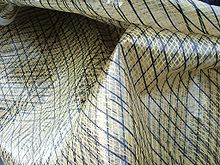Laminate sails
Laminate sails , also known as sandwich sails , are sails for regatta and cruising yachts that are made from a special composite material - a laminate . They owe their creation to the invention of Mylar , a film made from polyethylene terephthalate (PET).
The laminate is a composite material made of three layers. The core layer consists of a high-strength fabric made of carbon or aramid fibers, also known as carbon and Kevlar (brand name for aramid fibers). It gives the material high strength and dimensional stability while being light. The two outer layers consist of mylar or taffetta foil. Taffetta is a thin, robust polyester fabric . During lamination , the three layers are glued together under a pressure of 4 to 6 bar. Combinations of mylar + core layer + taffetta are also common.
Membrane sails
Membrane sails are a special form or further development of laminate sails. These sails, which until a few years ago were used exclusively in regattas , are now also used on cruising yachts due to lower production costs. In contrast to the laminate sail, in which the core layer consists of a uniform fabric, the high-strength fibers of the membrane sail are oriented to the load, according to the intended use and the type of load. The strength and direction of the forces to be expected are calculated beforehand with the help of software, and the cuts are positioned on the mylar or taffetta sheets under computer control. Some manufacturers produce membrane sails in a single piece.
Membrane sails are offered under the brand names Fiberlay, 3DL, D4, Millenium, Fusion-M, Genesis and Ultra.
Advantages and disadvantages
Compared to woven sails made of PET ( Dacron ) or other polyester fibers, the advantages of laminate sails are their lower weight and very high dimensional stability. Disadvantages are usually a shorter service life and greater sensitivity to buckling and mechanical damage.
